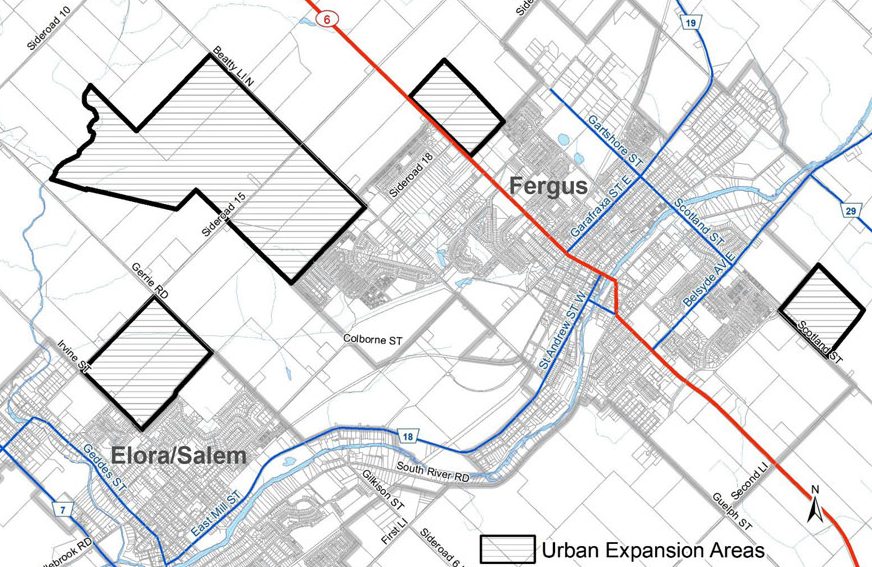GUELPH – Expanding municipal boundaries within Wellington County wasn’t on the list of changes the county was proposing when it filed amendments to its official plan last fall.
But when the province responded with its approval of the amendments, including many of its own, planners were surprised to find the urban boundaries of three local municipalities had been stretched by more than 1,000 acres.
The changes cannot be appealed, and local mayors and planners are wondering what else the province has up its sleeve as the county works through a review of its Official Plan, including urban boundary expansions that need to happen elsewhere.
The county’s Official Plan Amendment 119 (OPA 119), with a goal of setting the stage for future growth in line with provincial policy, was revised and filed in September 2022.
It largely contained amendments to the county’s growth structure using definitions from the province’s growth plan (“A Place to Grow”), and created a hierarchy of settlement areas.
On April 11, the province returned the document with 33 modifications, of which more than half are “fairly minor text changes,” according to county policy planning manager Sarah Wilhelm.
The “real story,” she told a recent planning committee on May 11, lies in urban boundary expansions.
The expansions include:
- just over 1,000 acres around Fergus and Elora in Centre Wellington;
- 37 acres adjacent to Rockwood in Guelph/Eramosa; and
- about 15 acres on the southwest corner of Clifford in the Town of Minto.
“There are a few surprises here,” she remarked as committee members, some shaking their heads, looked at maps displayed on two large-screen TVs.
“We weren’t consulted, the municipalities weren’t consulted; we’re not aware of what type of technical review was done by the province, if any,” Wilhelm told the committee.
“They’ve added things that weren’t even part of OPA 119, so it leaves the door open for other changes to be made that we maybe hadn’t even thought of. It’s a big unknown.”
Committee members, including county Warden Andy Lennox, Erin Mayor Michael Dehn and Centre Wellington Mayor Shawn Watters, are bothered by the lack of consultation and are unsure how changes will shake out.
One of the chief concerns heard at the committee was about how municipalities — Centre Wellington in particular, with more than 1,000 acres being brought into its urban boundary around Fergus and Elora — are going to handle servicing the lands with costly water, wastewater and road infrastructure.
Watters, acting as committee chair (Puslinch Mayor and chair James Seeley was absent), said the province should have consulted with municipalities about technical servicing information.
Watters suggested the changes “open up more agricultural land” for development and will encourage it.
County councillor Steve O’Neill, who noted much of the land north of Sideroad 15 in Centre Wellington is farmland, proposed a hypothetical: would the township have any say to a farmer who wanted to develop their farmland?
Watters could only respond by saying, “the devil’s in the details.”
“We don’t know how this is going to play out yet,” he added.
Warden Lennox called the changes “a setback” and wondered how agricultural lands could be serviced for development without burdening taxpayers.
“If we’re going to be asked to service these things that are more expensive to service, then we’re going to need additional financial support,” the warden said.
Dehn said there will come a point where expansion is no longer feasible because of limited groundwater supply and environmental capacity in rivers to handle treated sewage.
“Those are important kind of informational things that I think the province and the ministry needs to understand,” Watters remarked.
“I think we’re best, at this level, to understand those nuances.”
Erin county councillor Jeff Duncan said urban boundary expansion because of growth comes as no surprise.
The issue, as he described it, is the provincial government’s “lack of partnership.”
Duncan chastised the absence of local consultation, saying it has led to “confusion and angst.”
And yet, the province’s amendments aren’t all cause for alarm.
“We’re talking mostly about the negative side; these lands are not designated,” Lennox told the committee.
Explaining the nuance, Wilhelm said lands added by the province to urban boundaries are called employment or greenfield lands, but without designations assigned, local municipalities can control the timing and phasing of development, and policy about how lands are used.
“It’s an interesting situation to have, but it’s a good one,” Wilhelm told the committee, in part.
Other developments include:
- leaving growth plan policies related to the Greenbelt in place;
- removing a “Regionally Significant Economic Development Study Area” in Puslinch from the Greenbelt, with lands added elsewhere, as proposed by the county;
- holding off on a decision to consider the reestablishment of the “Hamlet of Puslinch”; and
- converting employment land for residential development (a change in Wellington North was not originally suggested by the county).
Detailed mapping of the urban boundary expansions only recently arrived, and Wilhelm told the Advertiser the county is waiting to hear back from the province about when officials will meet to discuss the amendment.
“At least now we’ve got good mapping that the public can see and appreciate the extent of what’s happening here,” she said.
“The reality is, we’re still reviewing the decision. We’re still talking internally about what our next steps should be.”
The most practical aspects, she said, are consolidating provincial changes into the county’s Official Plan, and continuing work to advance the county’s next amendment.




